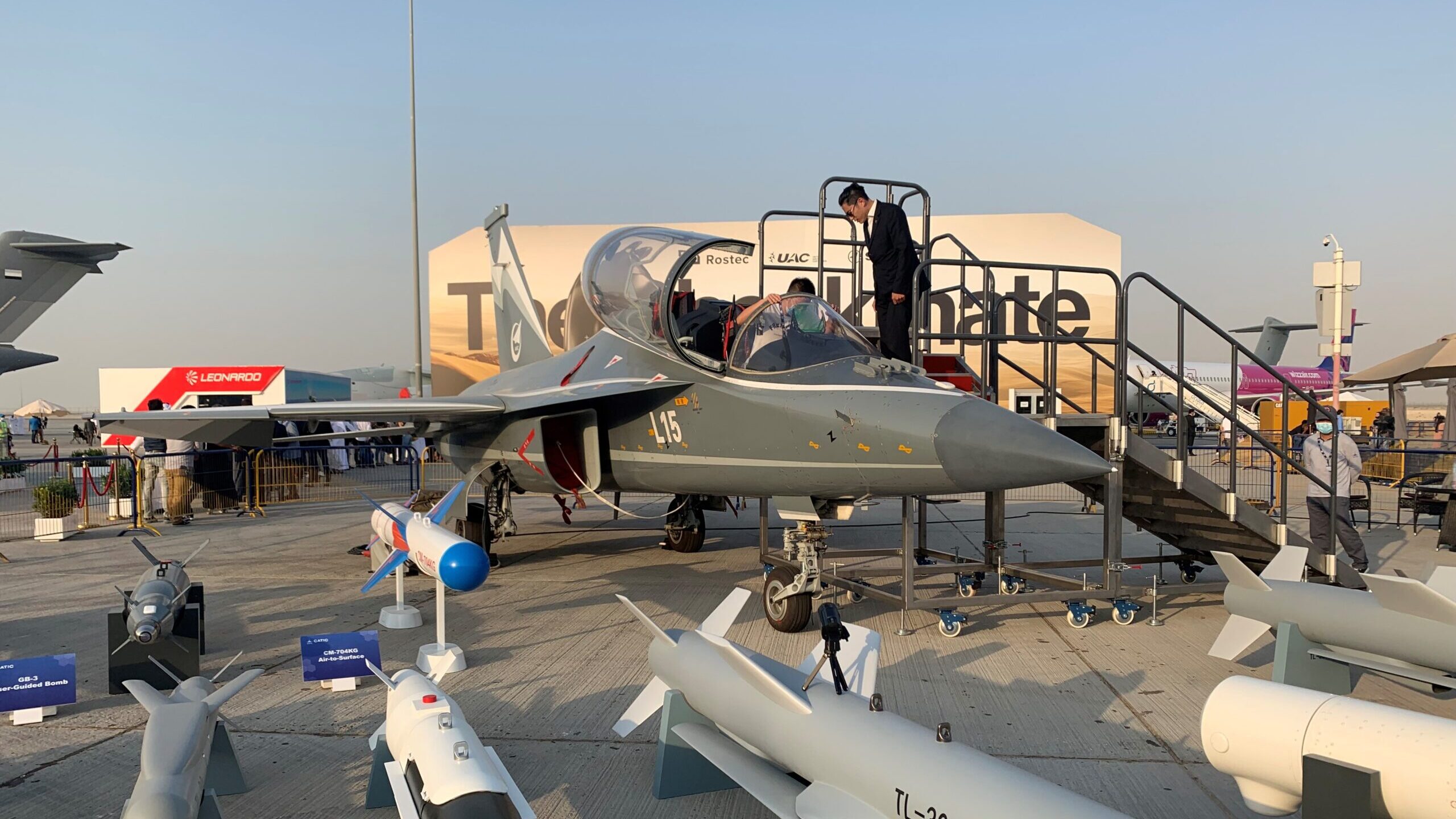
A Chinese L-15 attack trainer on display at the Dubai airshow 2021. (Chyrine Mezher/Breaking Defense)
DUBAI: China used last week’s Dubai Airshow to show off its upgraded version of the L-15 attack fighter trainer, as part of an effort to broaden its influence in the Mideast and North Africa.
Showcased both on ground and in the air during the five-day show, the latest variant of the aircraft features “high performance, reliability and cost efficiency,” a spokesperson at China National Aero-Technology Import & Export Corporation (CATIC) told Breaking Defense.
“A lot has changed since we first showcased the aircraft here in 2009,” he said. “With the advanced aerodynamic layout and avionics, the aircraft provides superior fighter-like performance.”
New upgrades mainly include advanced training and mission planning systems and improved avionics. It can also be fitted with a 23mm cannon pod, small diameter bomb, short and medium range air-to-air missile, and laser guided bombs weighing 250 and 500kg.
The aircraft can perform Lead-in fighter training (LIFT) for 4th and 5th gen fighters as well as undertake companion training in operational wings supported by the embedded training system (ETS) and mission planning and debriefing system. For combat, it can execute tactical missions like air combat, air strike, air reconnaissance, and Forward Air Control missions.
The spokesman pushed the message that the ability to be both a trainer and attack platform fits the needs for countries in the region, saying “The L-15’s presence at the Dubai Airshow is expected to attract potential long-term customers for China.”
Market penetration for the L-15 has yet to really happen. Zambia is the only export customer for the aircraft, having ordered six units, with the first batch received in 2016. (The Chinese air force “has ordered a total of 100 units from which several are now in operation,” the spokesperson claimed.)
And while the Middle East is a major market with enormous potential for China, they’ve yet to establish any real foothold in the region, despite Beijing’s signaled interest in expanding its regional ties. Perhaps the biggest Chinese announcement from this week was a relatively benign one: that the UAE and China are opening the first regional distribution hub for aircraft logistics in Abu Dhabi.
“China eclipses Russia both technologically and economically by leaps and bounds,” said Brandon C. Patrick, a Mid-East defense analyst. “Under Xi Jinping, it has sought to export its influence and establish itself as a superpower through various forms of cooperation including military aid and arms sales.”
RELATED: Russia hopeful UAE will join defense programs, pitching Su-75 Checkmate
However, “The Gulf states in particular have very deep pockets and can afford the very best, so they don’t need to compromise on quality,” said Patrick. “Whatever China offers would need to compete at the same level as the American, European and even Russian platforms toward which the MENA states traditionally lean.”
Instead, Patrick suggested, China should look for opportunities in North African states like Egypt or Algeria, where Russian manufactured aircraft are more prevalent. “In countries where US and European aircraft are more common, as in the Gulf states, the chances of a Chinese breakthrough are lower,” he added.
And if China can’t make inroads into the MENA countries with historic ties to the US, maybe it will look elsewhere. Word recently emerged that China and Iran have reached an expansive agreement for military and economic cooperation spanning the next 25 years.
“The agreement stands to make China Iran’s primary international ally and strongest backer from both military and economic perspectives,” Patrick said. “This won’t sit well with the Gulf states who view any move to strengthen Iran as a threat to regional stability.”
This makes it difficult to imagine the new China-Iran agreement as not having an impact on China’s potential list of customers in the region. “Based on that alone, we can surmise that China is targeting the non-gulf states for potential sales,” Patrick concluded.






















